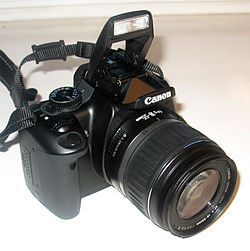- The Canon EOS 400D with kit lens EF-S 18-55mm and neck strap
- The 400D features a 2.5" TFT LCD (shown with optional battery grip)
- A Canon EOS 400D with the EF 50 mm f/1.8 II lens
 | |
| Overview | |
|---|---|
| Maker | Canon Inc. |
| Type | Digital single lens reflex camera |
| Lens | |
| Lens mount | Canon EF-S |
| Lens | Interchangeable |
| Sensor/medium | |
| Sensor | CMOS APS-C 22.2 mm × 14.8 mm (1.6× conversion factor) |
| Maximum resolution | 10.1 effective megapixels, 3,888 × 2,592 |
| Film speed | ISO 100 to 1600 |
| Storage media | CompactFlash Card Type I & II |
| Focusing | |
| Focus modes | One-Shot, Predictive AI Servo, automatic switching autofocus; Manual Focus |
| Focus areas | 9 AF points |
| Exposure/metering | |
| Exposure modes | Automatic shiftable Program, Shutter-priority, Aperture-priority, Auto Depth-of-field, Full auto, Programmed modes, Manual, E-TTL II autoflash program AE |
| Exposure metering | Full aperture TTL, 35-zone SPC |
| Metering modes | Evaluative, partial (approx. 9% at center of viewfinder), center-weighted average |
| Flash | |
| Flash | E-TTL II automatic built-in pop-up, 13 m ISO 100 guide number, 27 mm (equivalent in 35 format) lens focal length coverage; compatible with Canon EX Series Speedlite external hot shoe-mount flashes |
| Shutter | |
| Shutter | Focal-plane, vertical travel, mechanical |
| Shutter speed range | 1/4000 s to 30 s, bulb, 1/200 s X-sync |
| Continuous shooting | 3 frames/s for 27 JPEG frames or 10 raw frames |
| Viewfinder | |
| Viewfinder | Eye-level pentamirror SLR, 95% coverage, 0.8× magnification |
| Image processing | |
| Image processor | DIGIC 2 |
| White balance | Auto, Daylight, Shade, Cloudy, Tungsten Light, White Fluorescent Light, Flash, Manual, user-set |
| WB bracketing | +/- 3 stops in 1-stop increments |
| General | |
| LCD screen | 2.5 in (6.4 cm) color TFT LCD, 160° viewing angle, 230,000 pixels |
| Battery | NB-2LH Battery Pack |
| Dimensions | 126.5 mm × 94.2 mm × 65 mm (4.98 in × 3.71 in × 2.56 in) (W × H × D) |
| Weight | 510 g (18 oz) (body only) |
| Made in | Japan |
| Chronology | |
| Predecessor | Canon EOS 350D |
| Successor | Canon EOS 450D |
The EOS 400D, called Digital Rebel XTi in North America and EOS Kiss Digital X in Japan, [1] is an entry-level digital single-lens reflex camera introduced by Canon on 24 August 2006. [2]


